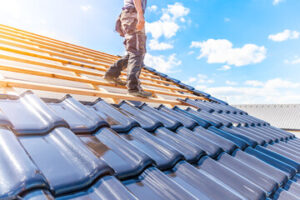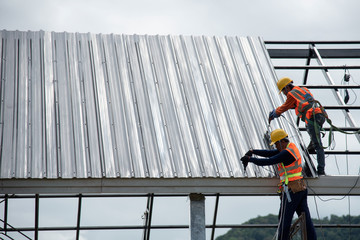The best way to start any roofing project is with a thorough inspection. This allows you to get a clear picture of the job’s scope and prevents misunderstandings later on.
Also, it’s important to set a timeline so clients know how long the project will realistically take to complete. Lastly, your contract should clearly outline the payment schedule and any additional costs. Contact Five Star Roofing and Contracting for professional help.
Professionals are trained in their craft and have specialized knowledge of the latest industry advancements. They also follow building codes and other laws in their area of expertise. Their professionalism is often evident in how they treat their customers and other contractors. Roofing professionals should always act in a courteous and respectful manner and provide clear, detailed proposals.
When you interview a potential contractor, be sure to ask about their experience and whether they have worked on projects similar to yours. It’s also a good idea to find out whether they offer a warranty on materials and workmanship. A quality warranty shows that a contractor has confidence in their work and is willing to stand by it.
Look for a company with consistent branding and a neat, organized appearance. Observe how quickly they respond to your questions and whether they answer them thoroughly. The way they conduct themselves during the initial consultation is an indicator of how they will conduct themselves throughout the project.
A quality roofing contractor should clearly outline the project timeline and payment terms in a written contract. This will help avoid misunderstandings and ensure that both parties are on the same page about expectations. They should also explain any additional fees or costs that may arise during the course of the project, and how they will be handled. A clear contract will also clarify that all work is performed by experienced and licensed roofers.
The contractor should also discuss the various roofing materials and explain their pros and cons. This will allow you to make an informed decision about the best roofing system for your home or business. They should be able to give you an estimate of how long the project will take, taking into account any weather delays or unforeseen issues that could occur.
A reputable contractor should be able to provide references from previous clients and provide testimonials of their work. You should also check out their online reviews to see what other people have said about them.
Licensing
Whether your project is new roof construction, repair, or replacement, it’s important to hire licensed professionals. They’ll have the necessary skills, experience, and expertise to ensure the best possible outcome. In addition, they’ll be held to strict safety standards and will comply with local building codes. Additionally, they’ll have access to quality roofing materials and can help you select the best roofing system for your specific needs.
Licensing requirements vary by state and even city, so it’s crucial to research the regulations in your area. Some states require a general contractor license, while others have specific licensing requirements for roofing contractors. You can find information about these requirements on the National Association of State Contractors Licensing Agencies (NASCLA) website or by contacting your state’s licensing board directly.
Once you’ve obtained your roofing license, it’s important to maintain it by meeting deadlines and completing renewals. Setting calendar reminders and using compliance software can help you stay on track. Additionally, you should continue to improve your roofing knowledge and skills through ongoing education. This will not only satisfy your regulatory obligations, but it will also increase your credibility and position you as a leader in the industry.
While unlicensed contractors may offer lower prices, they often lack the resources and skills needed to provide high-quality work. They may use substandard materials or fail to follow building codes, which can lead to costly repairs down the line. Additionally, they’re unlikely to offer a warranty or guarantee their work.
When selecting a roofing contractor, it’s important to verify their license, workers’ compensation, liability insurance, and warranty. This will help you avoid scams and ensure that they’re qualified to complete the job.
Obtaining a roofing license can be a challenging and time-consuming process, but it’s essential for the success of your roofing business. By preparing thoroughly, establishing a strong network, and staying in compliance, you can overcome the challenges of gaining a roofing license in multiple states. With the right approach, this critical step can be a catalyst for growth and connection within the roofing community.
Insurance
Insurance is an important part of any business, and roofing contractors are no exception. Clearly defining your insurance coverage in a contract helps you avoid problems down the road, and it also protects you if an issue arises during or after the work is done. In addition, it’s a good idea to include an indemnification clause that makes you and your client jointly responsible for damages or injuries sustained during the project.
General Liability: This is a must-have for all roofing contractors, and it protects you against claims for third-party bodily injury or property damage caused by your work. For example, if one of your employees accidentally breaks a window when working on a roof, this policy covers the repair costs. It can also cover legal fees if someone sues over slander or libel.
Commercial Auto Insurance: This is a must-have for any roofing contractor that uses vehicles in their business. It covers vehicles for both personal and business use, and it protects against damage or loss from accidents, theft, and other incidents that can occur while driving to or from job sites. It’s a legal requirement in most states, and it can help you manage your budget by lowering your tax liability.
Workers’ Compensation: If you hire employees, this is a mandatory insurance policy that protects them in the event of a workplace accident. It also helps you comply with state laws and regulations regarding worker’s compensation coverage.
Environmental Insurance: Roofing products like sealants, adhesives, coatings, and spraying equipment can create toxic fumes that are harmful to the environment. These can negatively impact air quality, causing health issues for anyone in the building. A contractor’s General Liability policy may exclude pollution-related losses, but a Contractors Pollution Liability policy can provide coverage for Bodily Injury and Property Damage related to these pollutants.
Inland Marine Insurance: This type of insurance is a must-have for any roofing company that has tools or materials stored offsite. It provides protection against damage or loss while in transit, and it’s a good idea to have this insurance if you need to transport items across NYC.
Warranty
Most roofing contractors will offer warranties on their services and products, protecting homeowners against unexpected repairs or material failures. These guarantees can vary in length and coverage, but are generally important for reassuring homeowners that they have quality workmanship and materials.
The two types of roof warranties homeowners should be aware of include contractor workmanship warranties and manufacturer material warranties. Workmanship warranties are provided by roofing contractors and typically cover installation errors, while manufacturer warranties provide protection for the integrity of the products used on a home’s roof. Both can be transferred to future homeowners, boosting a home’s market value and providing peace of mind for potential buyers.
Manufacturer warranties are usually offered free of charge and protect against product defects for a specified period of time. However, they do not typically include costs such as removing and disposing of existing roof materials or labor costs to install replacement parts. Additionally, they do not cover damage caused by weather events or other factors beyond their control.
An extended manufacturer warranty can help mitigate these risks by extending the coverage on both the material and labor costs of replacements or repairs. These extra benefits can be worth the additional investment for many homeowners.
Contractor workmanship warranties are usually less expensive and offer a more comprehensive level of coverage. They can be transferable to future owners and may extend for the lifespan of a roof. However, they tend to have a shorter term than the manufacturer warranty, and do not protect against costs incurred as a result of installation errors.
Depending on the type of roofing material, homeowner’s can also choose to opt for a manufacturer’s materials-only warranty. This option can reduce upfront costs, but it comes with a number of limitations and may violate the implied warranty of merchantability.
A roofing system is a complex and multifaceted structure that encompasses a wide range of components. Choosing a contractor with experience in the type of roofing you need and certifications from manufacturers can be vital to ensuring that your roof will stand up to the elements for years to come.




